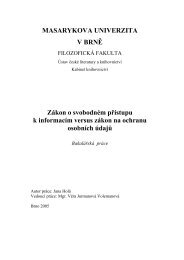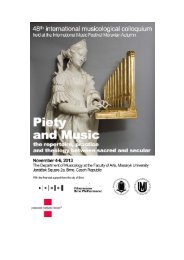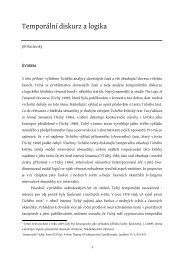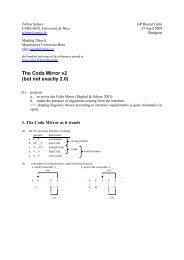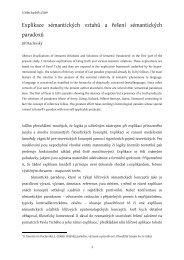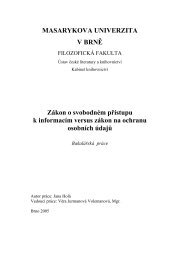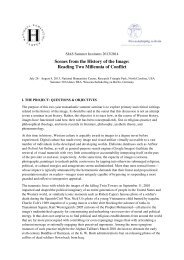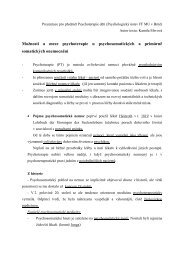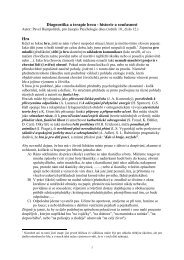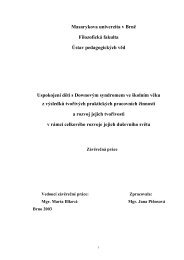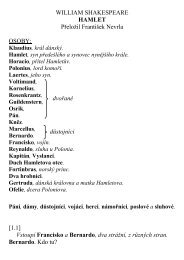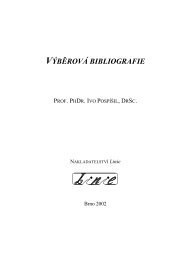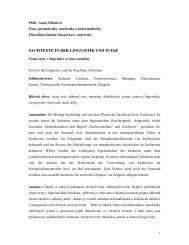The influence of cognitive psychology in a second language ...
The influence of cognitive psychology in a second language ...
The influence of cognitive psychology in a second language ...
Create successful ePaper yourself
Turn your PDF publications into a flip-book with our unique Google optimized e-Paper software.
<strong>The</strong> <strong><strong>in</strong>fluence</strong> <strong>of</strong> <strong>cognitive</strong> <strong>psychology</strong> <strong>in</strong> a <strong>second</strong><br />
<strong>language</strong> <strong>in</strong>struction<br />
Zuzana Horaničová<br />
Department <strong>of</strong> Foreign Languages, P. J. Šafárik University, Košice,<br />
Slovakia<br />
Cognitivism—the belief that much <strong>of</strong> human behavior can be understood if we<br />
understand first how people th<strong>in</strong>k—presently represents the ma<strong>in</strong>stream <strong>of</strong> th<strong>in</strong>k<strong>in</strong>g <strong>in</strong> both<br />
<strong>psychology</strong> and education (Bower and Hilgard 1981).<br />
<strong>The</strong> most prom<strong>in</strong>ent characteristics <strong>of</strong> the <strong>cognitive</strong> approach could be described as the<br />
focus on the processes underly<strong>in</strong>g complex learn<strong>in</strong>g.<br />
<strong>The</strong> development <strong>of</strong> cognitivism has <strong><strong>in</strong>fluence</strong>d learn<strong>in</strong>g theory and research <strong>in</strong> several<br />
significant ways (Shuell 1986; Schwartz and Reisberg 1991).<br />
Current <strong>cognitive</strong> approaches to learn<strong>in</strong>g stress that learn<strong>in</strong>g is an active, constructive,<br />
cumulative, and self-directed process that is dependent on the mental activities <strong>of</strong> the learner<br />
(Shuell 1986; Sternberg 1996). <strong>The</strong> <strong>cognitive</strong> orientation focuses on the mental activities <strong>of</strong><br />
the learner that lead to successful learn<strong>in</strong>g. This explicitly acknowledges the role <strong>of</strong><br />
meta<strong>cognitive</strong> processes and the use <strong>of</strong> various learn<strong>in</strong>g strategies. Memory and learn<strong>in</strong>g both<br />
require the learner to actively construct new knowledge and strategies (Rumelhart and<br />
Norman 1981). Transfer <strong>of</strong> <strong>in</strong>formation <strong>in</strong>to permanent storage is facilitated by rehearsal <strong>of</strong><br />
the <strong>in</strong>formation (particularly if the <strong>in</strong>formation is elaborated mean<strong>in</strong>gfully), by organization<br />
(e.g., categorization) <strong>of</strong> the <strong>in</strong>formation, by the use <strong>of</strong> metamemory strategies (e.g., writ<strong>in</strong>g<br />
lists or tak<strong>in</strong>g notes). <strong>The</strong> learners tend to remember better when knowledge is acquired<br />
through distributed practice across various study sessions, rather than through massed<br />
practise, although the distribution <strong>of</strong> time dur<strong>in</strong>g any given study session does not seem to<br />
affect transfer <strong>in</strong>to long-term storage (Anderson 1983; Sternberg 1996).<br />
S<strong>in</strong>ce learn<strong>in</strong>g is goal-orientated, the learner must somehow organise his or her<br />
resources and activities <strong>in</strong> order to achieve the goal <strong>of</strong> learn<strong>in</strong>g. Learners selectively encode<br />
<strong>in</strong>formation, sift<strong>in</strong>g out relevant from irrelevant <strong>in</strong>formation <strong>in</strong> the <strong>in</strong>put, <strong>in</strong> order to select<br />
<strong>in</strong>formation for further process<strong>in</strong>g (Deci and Ryan 1985). Motivation and <strong>in</strong>terest are central<br />
<strong>in</strong> how learners select and persist <strong>in</strong> process<strong>in</strong>g <strong>in</strong>formation: as a strong motivat<strong>in</strong>g force both<br />
<strong>in</strong>dividual and text-based <strong>in</strong>terests have a pr<strong>of</strong>ound facilitative effect on <strong>cognitive</strong> function<strong>in</strong>g<br />
and learn<strong>in</strong>g. Selectively encoded <strong>in</strong>formation is then selectively comb<strong>in</strong>ed and compared, i.e.<br />
it is rendered mean<strong>in</strong>gful by perceiv<strong>in</strong>g its relations to old <strong>in</strong>formation previously stored. This<br />
knowledge-acquisition processes operate on a variety <strong>of</strong> cues present <strong>in</strong> the material be<strong>in</strong>g<br />
learned, although utilization is affected by moderat<strong>in</strong>g variables such as a number <strong>of</strong><br />
occurrences, variability <strong>of</strong> contexts and importance <strong>of</strong> the to-be-learned <strong>in</strong>formation.<br />
Learn<strong>in</strong>g is cumulative <strong>in</strong> nature: noth<strong>in</strong>g has mean<strong>in</strong>g or is learned <strong>in</strong> isolation.<br />
Cognitive conceptions <strong>of</strong> learn<strong>in</strong>g place considerable importance on the role played by prior<br />
knowledge <strong>in</strong> the acquisition <strong>of</strong> new knowledge (Rumelhart 1980).<br />
In view <strong>of</strong> the <strong>cognitive</strong> approach to learn<strong>in</strong>g, the notion <strong>of</strong> effective <strong>language</strong> learn<strong>in</strong>g<br />
requires the active <strong>in</strong>volvement <strong>of</strong> the learner <strong>in</strong> the process. <strong>The</strong> approach emphasizes<br />
153
Zuzana Horaničová<br />
learn<strong>in</strong>g as a process result<strong>in</strong>g <strong>in</strong> an extension <strong>of</strong> mean<strong>in</strong>gs the learner is capable <strong>of</strong>, as<br />
someth<strong>in</strong>g that learners do, rather than be<strong>in</strong>g done to them (Kolb 1984). Moreover, the active<br />
nature <strong>of</strong> the way <strong>in</strong>dividuals learn is also seen as essentially <strong>in</strong>teractive, that is social: <strong>in</strong> the<br />
process <strong>of</strong> personal construction <strong>of</strong> knowledge learners negotiate mean<strong>in</strong>gs. In this view<br />
learners are active and responsible participants, not passive responders. Personal experience is<br />
seen as the focal po<strong>in</strong>t <strong>of</strong> learn<strong>in</strong>g.<br />
In addition to the <strong>cognitive</strong> factors, affective personality factors contribute to<br />
successful learn<strong>in</strong>g as well. Learn<strong>in</strong>g attitude and motivation are important predictors <strong>of</strong><br />
achievement (Deci and Ryan 1985). Intr<strong>in</strong>sic motivation is an important element <strong>in</strong> successful<br />
learn<strong>in</strong>g, and it is seen as a general drive towards self-direction and self-determ<strong>in</strong>ation. Selfdirection<br />
describes an attitude to learn<strong>in</strong>g where the learner assumes <strong>in</strong>creas<strong>in</strong>g responsibility<br />
for his or her learn<strong>in</strong>g (Little 1991; Hammond and Coll<strong>in</strong>s 1991).<br />
Changes <strong>in</strong> the way we th<strong>in</strong>k about learn<strong>in</strong>g and what we know about the way learn<strong>in</strong>g<br />
occurs have important implications for the way we th<strong>in</strong>k about teach<strong>in</strong>g.<br />
Understand<strong>in</strong>g the nature <strong>of</strong> learn<strong>in</strong>g process elicits the active role <strong>of</strong> learners <strong>in</strong> the<br />
process where they are responsible participants and not simply passive responders. In fact<br />
what the student does is actually more important <strong>in</strong> determ<strong>in</strong><strong>in</strong>g what is learned than what the<br />
<strong>in</strong>structor does. What this means is that the <strong>in</strong>structor’s role is different from the one<br />
frequently envisioned <strong>in</strong> traditional conceptions <strong>of</strong> teach<strong>in</strong>g with <strong>in</strong>structors most <strong>of</strong>ten<br />
monopolis<strong>in</strong>g either parts <strong>of</strong> or the whole learn<strong>in</strong>g process <strong>in</strong> which, <strong>in</strong> fact, students ought to<br />
be ga<strong>in</strong><strong>in</strong>g experience. What needs to change is the focus as well as the realisation that good<br />
teachers are not merely people who can articulate a large number <strong>of</strong> relevant facts and ideas;<br />
effective teachers must know how to get students actively engaged <strong>in</strong> learn<strong>in</strong>g activities that<br />
are appropriate for the desired outcomes. This task <strong>in</strong>volves the creation <strong>of</strong> the appropriate<br />
selection <strong>of</strong> content, an awareness <strong>of</strong> the <strong>cognitive</strong> processes that must be used by the learner<br />
<strong>in</strong> order to learn content, and an understand<strong>in</strong>g <strong>of</strong> how prior knowledge and exist<strong>in</strong>g<br />
knowledge structures determ<strong>in</strong>e what the student learns from the material presented.<br />
With the advent <strong>of</strong> <strong>cognitive</strong> theories <strong>of</strong> learn<strong>in</strong>g and knowledge <strong>of</strong> how specific<br />
learn<strong>in</strong>g processes <strong>in</strong> the learner are engaged by specific <strong>in</strong>structional variables, we now have<br />
a more viable body <strong>of</strong> scientific knowledge on how best to capitalise on the active nature <strong>of</strong><br />
learn<strong>in</strong>g and the variety <strong>of</strong> <strong>cognitive</strong> resources available to learners (Bereiter 1990).<br />
To understand the complexity <strong>of</strong> the learn<strong>in</strong>g processes and the behaviours associated<br />
with it poses the need for a functional unit <strong>in</strong> which the wide range <strong>of</strong> psychological<br />
properties are represented. <strong>The</strong> concept <strong>of</strong> the contextual module synthesises the entire<br />
complex <strong>of</strong> knowledge, skills, goals, and feel<strong>in</strong>gs associated with the learn<strong>in</strong>g situation. On<br />
the one hand, all the components are separately represented <strong>in</strong> the m<strong>in</strong>d, but, on the other<br />
hand, they are <strong>in</strong>terrelated and form an organic whole. <strong>The</strong> contextual module embodies the<br />
learner’s whole relationship to that context.<br />
Reth<strong>in</strong>k<strong>in</strong>g <strong>language</strong> learn<strong>in</strong>g <strong>in</strong> view <strong>of</strong> the <strong>cognitive</strong> process <strong>in</strong>volved <strong>in</strong> learn<strong>in</strong>g as<br />
well as the affective factors contribut<strong>in</strong>g to the process can provide effective guidance for the<br />
redesign <strong>of</strong> <strong>in</strong>structional contexts so that they would encourage the k<strong>in</strong>d <strong>of</strong> <strong>in</strong>tentional<br />
learn<strong>in</strong>g where learners perceive their active role as <strong>in</strong>telligent agents <strong>in</strong> the learn<strong>in</strong>g process.<br />
<strong>The</strong> goal is to enable the learner to become <strong>in</strong>creas<strong>in</strong>gly self-directed and responsible for his<br />
or her own learn<strong>in</strong>g. This process means a gradual shift <strong>of</strong> the <strong>in</strong>itiative to the learner,<br />
encourag<strong>in</strong>g him or her to br<strong>in</strong>g personal contributions and experiences.<br />
Another key issue is that <strong>of</strong> m<strong>in</strong>dful, mean<strong>in</strong>gful engagement, with students given<br />
opportunities to engage with <strong>in</strong>structional materials and become active contributors to their<br />
<strong>language</strong> learn<strong>in</strong>g rather than passive recipients <strong>of</strong> knowledge. A design model for a <strong>language</strong><br />
learn<strong>in</strong>g environment should foster the sense <strong>of</strong> personal engagement and discovery essential<br />
154
<strong>The</strong> <strong><strong>in</strong>fluence</strong> <strong>of</strong> <strong>cognitive</strong> <strong>psychology</strong> <strong>in</strong> a <strong>second</strong> <strong>language</strong> <strong>in</strong>struction<br />
to successful <strong>language</strong> learn<strong>in</strong>g. <strong>The</strong> teacher provides the rich context <strong>of</strong> authentic <strong>language</strong>,<br />
and the students discover <strong>language</strong> rather than study it: they are actively engaged <strong>in</strong><br />
negotiat<strong>in</strong>g mean<strong>in</strong>g and develop<strong>in</strong>g strategies for discovery. Students then are <strong>cognitive</strong>ly<br />
<strong>in</strong>volved <strong>in</strong> seek<strong>in</strong>g answers, mak<strong>in</strong>g generalisations, and test<strong>in</strong>g their hypotheses.<br />
<strong>The</strong> concept <strong>of</strong> the contextual module as the functional unit <strong>of</strong> cognition which<br />
synthesise learner: learn<strong>in</strong>g environment relations is adapted to the learn<strong>in</strong>g context. <strong>The</strong> aim<br />
is to develop a coherent <strong>in</strong>struction module which is organized around goals <strong>of</strong> personal<br />
knowledge construction. This will encourage students to engage <strong>in</strong> active and mean<strong>in</strong>gful<br />
<strong>in</strong>formation process<strong>in</strong>g.<br />
<strong>The</strong> learn<strong>in</strong>g goals arise out <strong>of</strong> the basic theoretical premises <strong>in</strong> the discussion <strong>of</strong> the<br />
<strong>cognitive</strong> approach to learn<strong>in</strong>g and give emphasis on the development <strong>of</strong> message-based<br />
fluency <strong>in</strong>tegrat<strong>in</strong>g the <strong>language</strong> skills (Meskill and Rangelova, <strong>in</strong> press).<br />
<strong>The</strong> basic theoretical considerations <strong>of</strong> the <strong>cognitive</strong> approach to <strong>language</strong> learn<strong>in</strong>g<br />
underlie the choice <strong>of</strong> <strong>in</strong>struction and learn<strong>in</strong>g procedures as well. Interactional patterns,<br />
<strong>in</strong>struction practises, and learn<strong>in</strong>g behaviours take account <strong>of</strong> the psychol<strong>in</strong>guistic and<br />
<strong>cognitive</strong> processes <strong>in</strong>volved <strong>in</strong> <strong>language</strong> learn<strong>in</strong>g.<br />
<strong>The</strong> learn<strong>in</strong>g and teach<strong>in</strong>g activities that are selected to realise the objectives and the<br />
syllabus organization are guided by the understand<strong>in</strong>g that what learners remember is the<br />
product <strong>of</strong> their <strong>in</strong>terpretation, not the raw data themselves. <strong>The</strong>refore, learn<strong>in</strong>g and<br />
<strong>in</strong>struction activities are designed to <strong>in</strong>volve concrete experience; reflective observation;<br />
abstract conceptualization; active experimentation.<br />
A f<strong>in</strong>al theoretical consideration is the development <strong>of</strong> autonomy-support<strong>in</strong>g structures<br />
that facilitate <strong>in</strong>dependence <strong>of</strong> learn<strong>in</strong>g, <strong>of</strong>fer<strong>in</strong>g the learner opportunities for choice and<br />
decision mak<strong>in</strong>g, and, <strong>in</strong> general, promot<strong>in</strong>g the learner’s self-determ<strong>in</strong><strong>in</strong>g status.<br />
Direct learner <strong>in</strong>volvement <strong>in</strong> activity development and organization enhances the self<br />
determ<strong>in</strong><strong>in</strong>g status <strong>of</strong> students. Moreover, such activities draw students <strong>in</strong>to the teach<strong>in</strong>glearn<strong>in</strong>g<br />
process <strong>in</strong> an active and reflective manner; they <strong>in</strong>volve learners <strong>in</strong> aspects <strong>of</strong><br />
diagnosis and evaluation which are generally considered to be the teacher’s prerogative.<br />
<strong>The</strong> <strong>in</strong>tegration <strong>of</strong> <strong>language</strong> skills re<strong>in</strong>forces the learn<strong>in</strong>g process through the three part<br />
structure <strong>of</strong> the activities design: learn<strong>in</strong>g <strong>language</strong>, learn<strong>in</strong>g through <strong>language</strong>, learn<strong>in</strong>g about<br />
<strong>language</strong>. Students start with top-down process<strong>in</strong>g: they are exposed to <strong>in</strong>put which they<br />
process for mean<strong>in</strong>g while at the same time selectively attend<strong>in</strong>g to specific <strong>language</strong> features.<br />
Students, by their prior knowledge generate expectations and comb<strong>in</strong>e them, with the<br />
<strong>language</strong> <strong>in</strong>put to construct or reconstruct the mean<strong>in</strong>g. While <strong>in</strong>terpret<strong>in</strong>g the <strong>language</strong> <strong>in</strong>put,<br />
students assimilate and <strong>in</strong>tegrate new <strong>in</strong>formation to already exist<strong>in</strong>g schemata <strong>of</strong> stored<br />
knowledge. As a result, they record the gist <strong>of</strong> their experiences with the <strong>language</strong> <strong>in</strong>put, an<br />
<strong>in</strong>tegrated understand<strong>in</strong>g <strong>of</strong> the material, and not the exact orig<strong>in</strong>al sentences and word order<br />
<strong>of</strong> the sentences. To get students to consciously focus on the specific l<strong>in</strong>guistic features that<br />
have guided them <strong>in</strong> mak<strong>in</strong>g their <strong>in</strong>terpretations, are alerted to specific context details and<br />
<strong>language</strong> features.<br />
References:<br />
Anderson, J. (1985) Cognitive Psychology and Its Implications. New York: Freeman.<br />
Bereiter, C. (1990) ‘Aspects <strong>of</strong> an Educational Learn<strong>in</strong>g <strong>The</strong>ory’ Review <strong>of</strong> Educational<br />
Research 60: 603-624.<br />
Bower, G. and Hilgard, E. (1981) <strong>The</strong>ories <strong>of</strong> Learn<strong>in</strong>g. Englewood Cliffs NJ: Prentice-Hall.<br />
155
Zuzana Horaničová<br />
Deci, E. and Ryan, R. (1985) ‘<strong>The</strong> General Causality Orientations Scale: self determ<strong>in</strong>ation <strong>in</strong><br />
Personality’ Journal <strong>of</strong> Research <strong>in</strong> Personality 19: 109-134.<br />
Hammond, M. and Coll<strong>in</strong>s, R. (1991) Self-Directed Learn<strong>in</strong>g: Critical Practice. London:<br />
Kogan Page.<br />
Kolb, D. (1984) Experiential Learn<strong>in</strong>g. Experience as the Source <strong>of</strong> Learn<strong>in</strong>g and<br />
Development. Englewood Cliffs: Prentice Hall.<br />
Little, D. (1991) Learner Autonomy: def<strong>in</strong>itions, issues and Problems. Dubl<strong>in</strong>: Authentik.<br />
Rumelhart, D. (1980) ‘Schemata: <strong>The</strong> Build<strong>in</strong>g Blocks <strong>of</strong> Cognition‘ <strong>in</strong> Spiro, J., Bruce, B.<br />
and Brewer, W. (eds) <strong>The</strong>oretical Issues <strong>in</strong> Read<strong>in</strong>g Comprehension Hillsdale NJ:<br />
Lawrence Erlbaum Associates.<br />
Schwartz, B. and Reisberg, D. (1991) Learn<strong>in</strong>g and Memory. New York, NY: W. W. Norton<br />
& Company, Inc.<br />
Shuell, T. (1986) ‘Cognitive Conceptions <strong>of</strong> Learn<strong>in</strong>g’ Review <strong>of</strong> Educational Research 56:<br />
411-436.<br />
Sternberg, R. (1996) Cognitive Psychology. New York NY: Holt, R<strong>in</strong>ehart and W<strong>in</strong>ston, Inc.<br />
156



